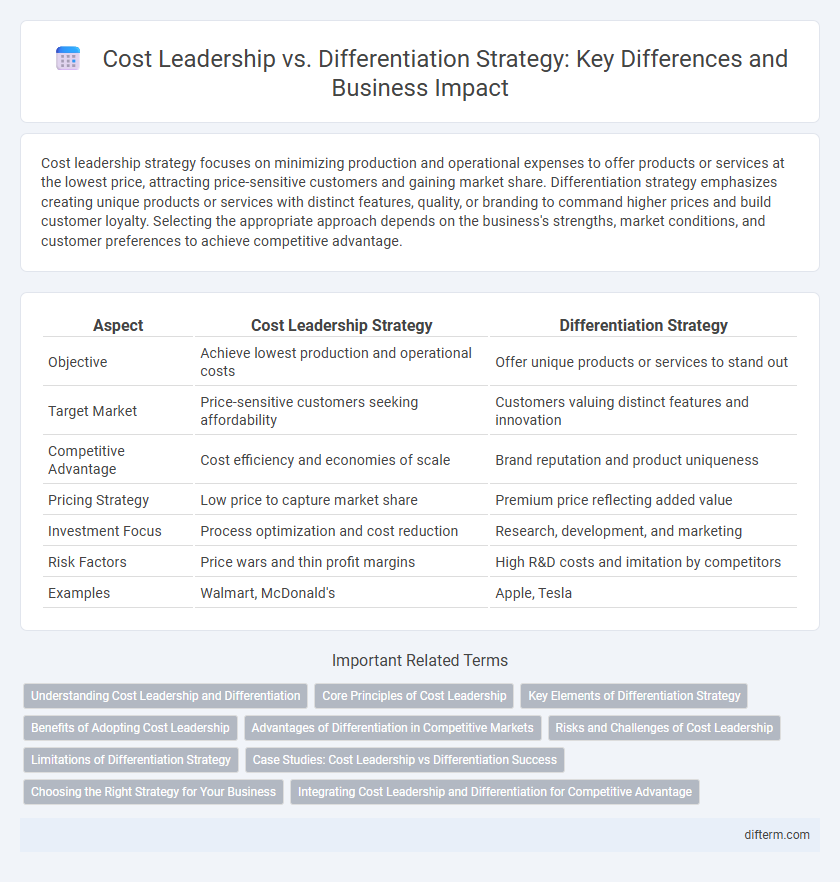Cost leadership strategy focuses on minimizing production and operational expenses to offer products or services at the lowest price, attracting price-sensitive customers and gaining market share. Differentiation strategy emphasizes creating unique products or services with distinct features, quality, or branding to command higher prices and build customer loyalty. Selecting the appropriate approach depends on the business's strengths, market conditions, and customer preferences to achieve competitive advantage.
Table of Comparison
| Aspect | Cost Leadership Strategy | Differentiation Strategy |
|---|---|---|
| Objective | Achieve lowest production and operational costs | Offer unique products or services to stand out |
| Target Market | Price-sensitive customers seeking affordability | Customers valuing distinct features and innovation |
| Competitive Advantage | Cost efficiency and economies of scale | Brand reputation and product uniqueness |
| Pricing Strategy | Low price to capture market share | Premium price reflecting added value |
| Investment Focus | Process optimization and cost reduction | Research, development, and marketing |
| Risk Factors | Price wars and thin profit margins | High R&D costs and imitation by competitors |
| Examples | Walmart, McDonald's | Apple, Tesla |
Understanding Cost Leadership and Differentiation
Cost leadership strategy emphasizes achieving the lowest production and operational costs in an industry to offer competitive pricing and attract price-sensitive customers. Differentiation strategy focuses on creating unique products or services with distinct features, quality, or brand image to justify premium pricing and foster customer loyalty. Understanding the core principles and implementation of these strategies enables businesses to align resources effectively, optimize market positioning, and drive sustainable competitive advantage.
Core Principles of Cost Leadership
Cost leadership strategy revolves around achieving the lowest production and operational costs in an industry to offer competitive pricing while maintaining profitability. Key principles include economies of scale, efficient supply chain management, and rigorous cost control across all business functions. Companies like Walmart and Ryanair exemplify cost leadership by leveraging standardized processes and reducing overhead to dominate price-sensitive markets.
Key Elements of Differentiation Strategy
Key elements of differentiation strategy include unique product features, exceptional customer service, and strong brand identity that create perceived value beyond price. Businesses invest in innovation, quality improvements, and exclusive technologies to set their offerings apart from competitors. These factors drive customer loyalty and enable premium pricing, enhancing long-term profitability.
Benefits of Adopting Cost Leadership
Adopting a cost leadership strategy enables businesses to achieve a competitive advantage by minimizing production and operational expenses, which results in lower prices for consumers and increased market share. This approach enhances profit margins even in highly competitive markets by attracting price-sensitive customers and driving higher sales volumes. Furthermore, maintaining cost efficiency strengthens resilience against price wars and economic downturns, safeguarding long-term business sustainability.
Advantages of Differentiation in Competitive Markets
Differentiation strategy allows businesses to create unique products or services that stand out in competitive markets, attracting loyal customers willing to pay premium prices. This approach enhances brand equity and reduces price sensitivity, leading to higher profit margins and sustainable competitive advantage. By emphasizing innovation and quality, firms can effectively respond to changing consumer preferences and limit direct price competition.
Risks and Challenges of Cost Leadership
Cost leadership strategy faces risks such as price wars, which can erode profit margins and damage industry stability. Challenges include maintaining low operational costs without compromising quality or innovation, potentially leading to a loss of customer loyalty. Firms may also struggle with inflexibility, becoming vulnerable to market changes and technological disruptions.
Limitations of Differentiation Strategy
Differentiation strategy faces limitations such as higher production and marketing costs that can reduce profit margins. It may also lead to customer alienation if product uniqueness does not align with market preferences. Furthermore, fast-moving competitors can imitate features, eroding the differentiation advantage quickly.
Case Studies: Cost Leadership vs Differentiation Success
Walmart exemplifies cost leadership by leveraging economies of scale and efficient supply chain management to offer low prices, capturing a broad customer base. In contrast, Apple demonstrates differentiation through innovative product design, premium quality, and strong brand loyalty, allowing for higher price points and customer retention. Both strategies achieve success by aligning operational practices with distinct market positioning, evident in their sustained competitive advantages and financial performance.
Choosing the Right Strategy for Your Business
Selecting between cost leadership and differentiation strategies hinges on understanding your target market and competitive environment. Cost leadership strategy emphasizes minimizing production and operational expenses to offer lower prices, appealing to price-sensitive customers. Differentiation strategy focuses on creating unique products or services with superior quality or features, attracting customers willing to pay a premium for added value.
Integrating Cost Leadership and Differentiation for Competitive Advantage
Integrating cost leadership and differentiation strategies enables businesses to achieve a unique competitive advantage by delivering high-quality products or services at lower costs. This hybrid approach optimizes operational efficiency while fostering innovation, allowing companies to cater to diverse customer needs without sacrificing margin. Successful firms leverage technologies, supply chain management, and brand positioning to balance cost control with differentiated value propositions in dynamic markets.
Cost Leadership vs Differentiation Strategy Infographic

 difterm.com
difterm.com